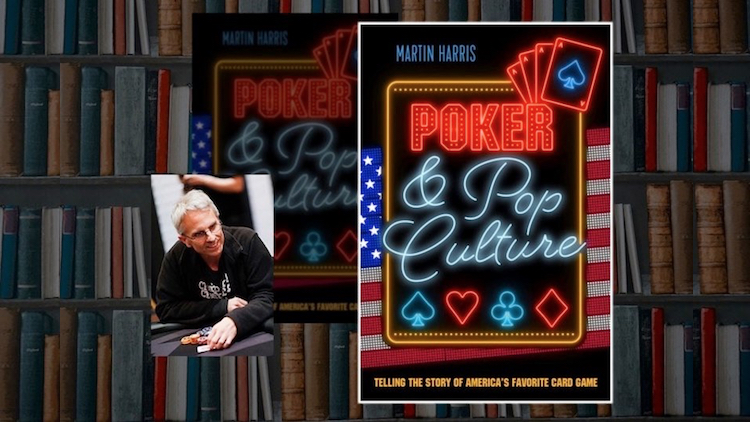Poker & Pop Culture: Telling the Story of America’s Favorite Card Game by PokerStars Blog’s own Martin Harris is a detailed history of poker and the game’s portrayal in movies, on television, in magazines and books, in music, in paintings, and in other areas of popular culture.
Anthony Holden, author of Big Deal and Bigger Deal, has described the book as “a thorough, well-informed and highly entertaining exploration of the cultural riches bred by poker, explaining why the game remains so quintessentially American while growing ever more universal.”
The book covers poker’s origins and early history all of the way through to the present, describing how it was first played on steamboats and saloons, in Civil War encampments, and eventually in clubs, private homes, casinos, and on the computer. It discusses the many ways poker has intersected with other areas of American life including business, sports, entertainment, politics, and warfare.
The book also comprehensively considers the significance of poker’s portrayal in “mainstream” cultural productions. To give an example of the book’s scope, Harris discusses around 130 different films, 40 television series, and 50 songs that involve poker in some fashion — and that’s only in a few of the chapters!
The following excerpt comes from the chapter “Poker in Folklore” in which Harris has gathered several famous and entertaining tales from poker’s past, all of which help show the game’s capacity to generate great stories — true, fictional, and in between.
The Endless Hand
Stories of poker sessions lasting days, weeks, or months are peppered throughout the game’s history, but there aren’t as many accounts of individual hands of especially long duration. However, another tale from poker folklore also dating from the 1890s seems determined to establish for all time an unbreakable standard for the longest poker hand ever played.
The story is sometimes attributed to James Stephen “Big Jim” Hogg, governor of Texas from 1891-95, who was said to tell “more good stories of the national game than any other public man in this section of the country” even though he was not a poker player himself. It involves two neighbors living in Austin — Old Man Morgan and Major Danielson — “both enormously rich.” The pair played poker nearly every night, occasionally losing significant sums although “the balance was generally pretty even.”
On the night of June 15, 1853 at 8 p.m. — the story becomes conspicuously specific — a situation arose in game after dinner in which both players found themselves having been dealt big hands. (Given the lack of reference to a draw, they may be playing without one.) Danielson then bets and Morgan raises, and despite the action thereafter being described as “fast and furious” the raises stretch onward for another couple of hours until midnight. The pot balloons to about $10,000.
The betting continues for another couple of hours until both men exhaust all of their chips in what had originally been “a quiet little game of table stakes.” They agree to lift that restriction, and after continuing to raise each other “the table fairly groaned beneath the weight of wealth.” By dawn the table actually breaks, and the bets continue throughout the following day with the pair only pausing for meals. “Then they adjourned for six hours to sleep, and resumed the play again at midnight,” Hogg says. “They kept it up all the rest of the week, and for the remainder of the year.” By then each player “had invested his entire fortune — cash, bonds, stocks, live stock, land, houses, everything in that game,” thereby attracting the attention of people from neighboring cities coming to Austin to witness the spectacle.
Some eight years after they had started “the war came along, but the game never stopped,” and since both men were too old to fight they continued playing the hand. “Finally it became apparent that neither would ever call the other, so the hands were sealed up separately in tin boxes, and the rest of the deck was put in another one.” The boxes were deposited at the bank in Austin, and the pair “went on with their betting,” adding whatever income they made to the ever-growing pot.
Both men died in 1872, according to Hogg’s account, having left instructions in their wills for their eldest sons to continue the hand. “The heirs did so for five years,” until “one of them was killed in a railroad accident and the other went crazy.” However their eldest sons — the grandsons of the original players — picked up the action from there, and “every time either of them gets a few hundred dollars together, he goes over to Austin and raises the other fellow out of his boots.”
The story concludes with the teller explaining how as long as either of the men continues to earn an income, the hand will continue, and “the world will never know what sort of hands old man Morgan and Maj. Danielson drew on that balmy June evening forty-one years ago.” Some versions add that the heirs know the hands, but are “sworn to secrecy.”
It is tempting to compare the story of the endless poker hand with later, realistic accounts of players unable to muster the strength to pull themselves from the table. In The Biggest Game in Town (1983), Eric Drache describes to Al Alvarez feeling as though he were “anteing himself to death” while spending the majority of his waking hours playing poker while thinking, “I wonder where this is going to end. ” Drache evokes the crisis David Hayano dubbed “the existential game” in his 1982 study, Poker Faces: The Life and Work of Professional Card Players. “To the full-time gambler time is not structured by clock hours and rigid routines but rather by the unpredictable flow and pattern in the fall of cards,” Hayano writes. “Time is experienced as passing very quickly from game to game, with virtually no change in the physical surroundings,” causing players to become gradually unmoored from the usual markers of temporal change and their effects. Along with other factors, such a circumstance “manifests itself in an existential, if not socio-psychological, kind of imbalance.”
Jesse May explores a similar paradox in his 1998 novel Shut Up and Deal in which grinder Mickey Dane endeavors throughout to “stay in action” while also constantly wondering about the goal of a game in which “time stands still and there’s no need to think in any terms other than up or down, aces and kings… a very pleasant place to spend eternity.”
That said, comparing Governor Hogg’s yarn with these deeper poker-related inquiries into the human condition probably misses the point. Using deliberate hyperbole — not unlike the tales of legendary lumberjack Paul Bunyan that first appeared a few years later — the story of “the great Morgan-Danielson game” provides a humorous take on the extent to which poker had become an all-consuming obsession for many Americans.
Poker & Pop Culture: Telling the Story of America’s Favorite Card Game is available in paperback, as an e-book, and as an audio book (read by the author) at D&B Poker.
D&B Publishing (using the imprint D&B Poker) was created by Dan Addelman and Byron Jacobs 15 years ago. Since then it has become one of the leading publishers of poker books with titles by Phil Hellmuth, Jonathan Little, Mike Sexton, Chris Moorman, Dr. Patricia Cardner, Lance Bradley, Greg Raymer and more, all of which are available at D&B Poker.
Back to Top







